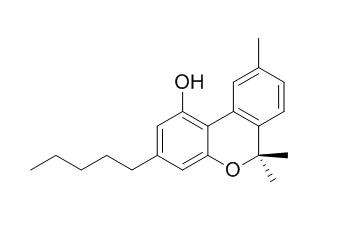Cannabinol
Cannabinol activates capsaicin-sensitive sensory nerves via a CB1 and CB2 cannabinoid receptor-independent mechanism.
Inquire / Order:
manager@chemfaces.com
Technical Inquiries:
service@chemfaces.com
Tel:
+86-27-84237783
Fax:
+86-27-84254680
Address:
1 Building, No. 83, CheCheng Rd., Wuhan Economic and Technological Development Zone, Wuhan, Hubei 430056, PRC
Providing storage is as stated on the product vial and the vial is kept tightly sealed, the product can be stored for up to
24 months(2-8C).
Wherever possible, you should prepare and use solutions on the same day. However, if you need to make up stock solutions in advance, we recommend that you store the solution as aliquots in tightly sealed vials at -20C. Generally, these will be useable for up to two weeks. Before use, and prior to opening the vial we recommend that you allow your product to equilibrate to room temperature for at least 1 hour.
Need more advice on solubility, usage and handling? Please email to: service@chemfaces.com
The packaging of the product may have turned upside down during transportation, resulting in the natural compounds adhering to the neck or cap of the vial. take the vial out of its packaging and gently shake to let the compounds fall to the bottom of the vial. for liquid products, centrifuge at 200-500 RPM to gather the liquid at the bottom of the vial. try to avoid loss or contamination during handling.
Food Funct.2023, 14(9):4354-4367.
Plant Growth Regulation2020, 90(2):383-392
Pak J Pharm Sci.2023, 36(1):51-57.
Progress In Microbes & Molecular Biology2025, 8,1:a0000470.
Integr Med Res.2021, 10(3):100723.
Korean J. of Horticultural Sci. & Tech. 2017, 793-804
Proc Biol Sci.2024, 291(2015):20232578.
Institute of Food Science & Technology2021, 18 December.
ACS Pharmacol.Transl.Sci.2024, 4c00003.
J Ethnopharmacol.2023, 309:116302.
Related and Featured Products
J Neurosci. 2002 Jun 1;22(11):4720-7.
Delta 9-tetrahydrocannabinol and cannabinol activate capsaicin-sensitive sensory nerves via a CB1 and CB2 cannabinoid receptor-independent mechanism.[Pubmed:
12040079 ]
Although Delta(9)-tetrahydroCannabinol (THC) produces analgesia, its effects on nociceptive primary afferents are unknown. These neurons participate not only in pain signaling but also in the local response to tissue injury.
METHODS AND RESULTS:
Here, we show that THC and Cannabinol induce a CB(1)/CB(2) cannabinoid receptor-independent release of calcitonin gene-related peptide from capsaicin-sensitive perivascular sensory nerves. Other psychotropic cannabinoids cannot mimic this action. The vanilloid receptor antagonist ruthenium red abolishes the responses to THC and Cannabinol. However, the effect of THC on sensory nerves is intact in vanilloid receptor subtype 1 gene knock-out mice.
CONCLUSIONS:
The THC response depends on extracellular calcium but does not involve known voltage-operated calcium channels, glutamate receptors, or protein kinases A and C. These results may indicate the presence of a novel cannabinoid receptor/ion channel in the pain pathway.
Arch Oral Biol . 2019 Aug;104:33-39.
Cannabidiol, cannabinol and their combinations act as peripheral analgesics in a rat model of myofascial pain[Pubmed:
31158702]
Abstract
Objective: This study investigated whether local intramuscular injection of non-psychoactive cannabinoids, cannabidiol (CBD), Cannabinol (CBN), cannabichromene (CBC) and their combinations can decrease nerve growth factor (NGF)-induced masticatory muscle sensitization in female rats.
Design: In awake rats, changes in mechanical sensitivity induced by intramuscular injection of NGF and cannabinoids were measured by applying an electronic von Frey hair over the masseter muscle to measure the withdrawal response. The effect of CBD (5 mg/ml) and CBN (1 mg/ml) or their combinations CBD/CBN (1:1 mg/ml or 5:1 mg/ml) were assessed. To confirm a peripheral action, electrophysiological experiments were undertaken in anesthetized rats to examine whether intramuscular injections of CBD (5 mg/ml) and CBN (1 mg/ml) altered the mechanical threshold of masticatory muscle mechanoreceptors.
Results: In behavioral experiments, CBD (5 mg/ml) or CBN (1 mg/ml) decreased NGF-induced mechanical sensitization. Combinations of CBD/CBN induced a longer-lasting reduction of mechanical sensitization than either compound alone. No significant change in mechanical withdrawal threshold was observed in the contralateral masseter muscles and no impairment of motor function was found with the inverted screen test after any of the treatments. Consistent with behavioral results, CBD (5 mg/ml), CBN (1 mg/ml) and the combination of CBD/CBN (1:1 mg/ml) increased the mechanical threshold of masseter muscle mechanoreceptors. However, combining CBD/CBN (5:1 mg/ml) at a higher ratio reduced the duration of this effect. This may indicate an inhibitory effect of higher concentrations of CBD on CBN.
Conclusions: These results suggest that peripheral application of these non-psychoactive cannabinoids may provide analgesic relief for chronic muscle pain disorders such as temporomandibular disorders and fibromyalgia without central side effects.
Keywords: Cannabichromene; Cannabidiol; Cannabinoid receptors; Cannabinol; Masseter muscle; Nerve growth factor.



